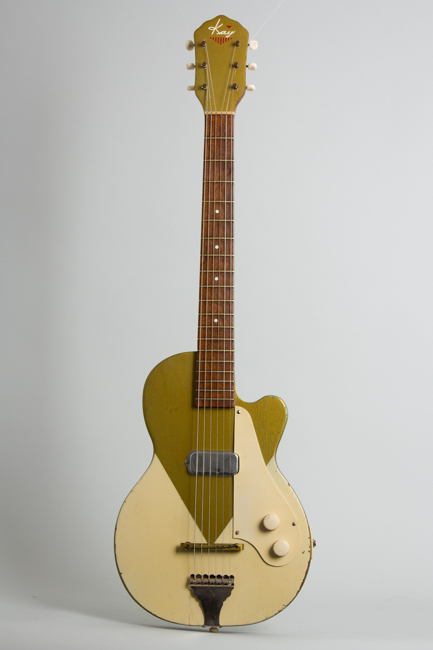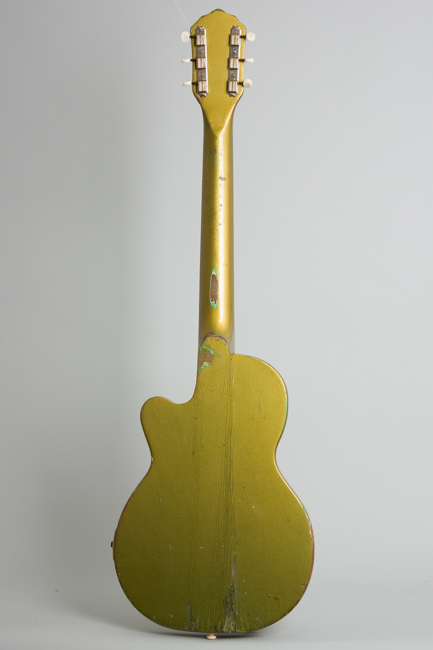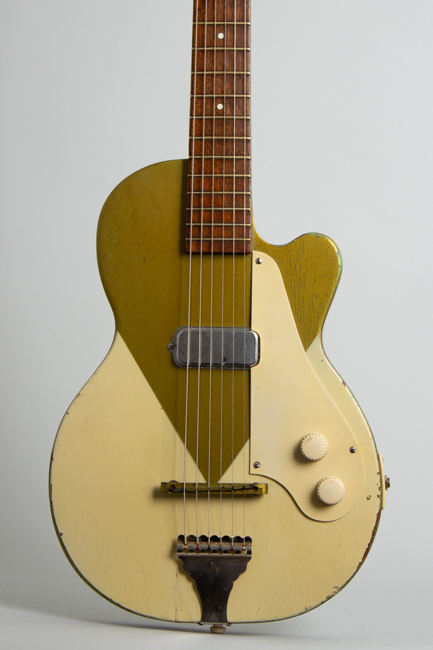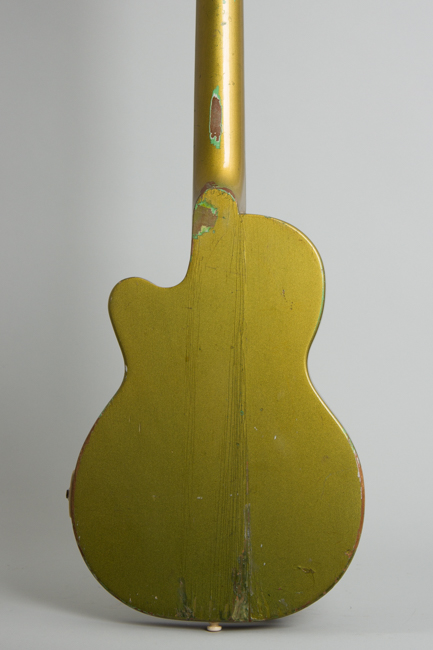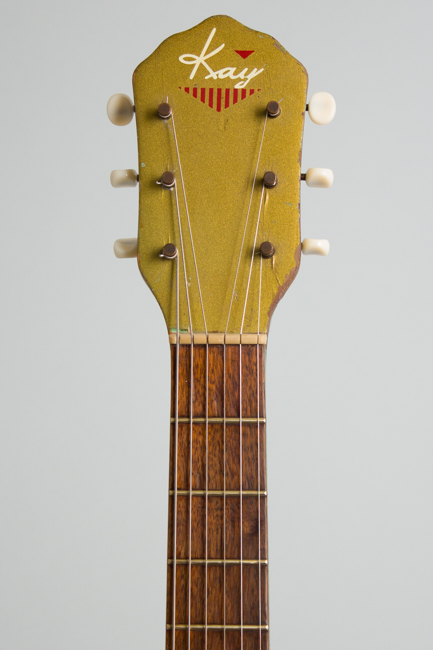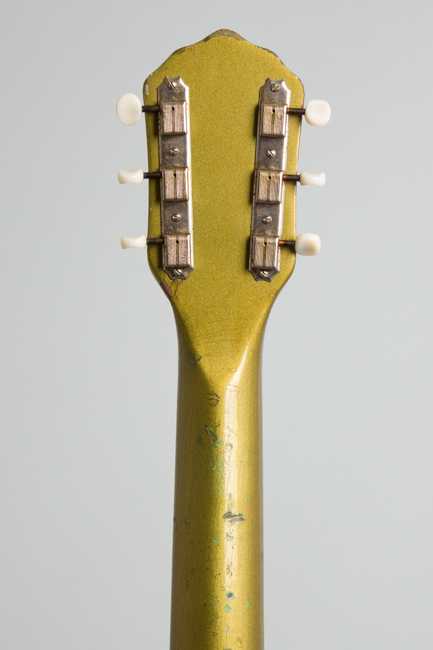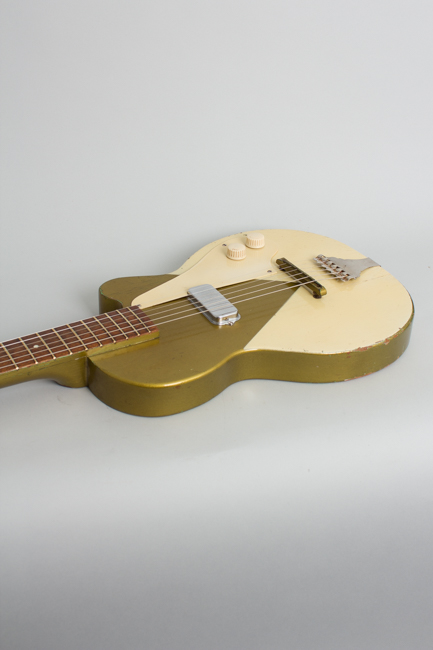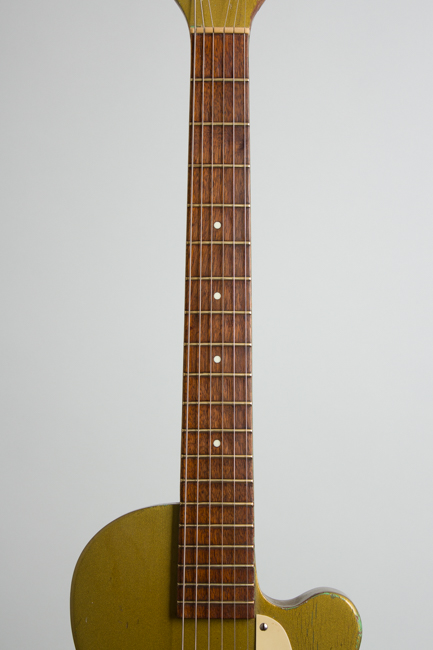K-136 Solid Body Electric Guitar, made by Kay (1958)
This item has been sold.
Item # 9633
Prices subject to change without notice.
K-136 Model Solid Body Electric Guitar, made by Kay (1958), made in Chicago, two tone green lacquer finish, hardwood body and neck, rosewood fingerboard, black gig bag case.
This festive looking guitar is the primal Kay solidbody, the K-136. This is a fairly late iteration of this Chicago-made electric slab-o-wood made in 1958; the volume pot code is the 19th week of that year This one matches the version shown in Kay's 1957 catalog at a list price $73.00.
This is a typical early solidbody design, and despite its relative obscurity an innovative one as well. Jumping into the new early '50's solidbody market Chicago competitors Kay and Harmony hit on generally similar designs, both somewhat inspired by Gibson's Les Paul. These were both more compact and simple instruments with small single cutaway bodies and integral full-length thru-body necks, something Rickenbacker usually gets the credit for pioneering. While Harmony's Stratotone is better remembered (the power of a catchy name?) Kay's K-136 is in some ways a better designed guitar.
The most notable feature of the K-136 is the neck-it is VERY chunky with a beefy round profile that gets much deeper towards the body and a thick rosewood fingerboard. The body is flat topped, deeper than the Harmony with less rounded edges giving it a chunkier feel. The entire guitar is finished in a very eye-catching two-tone metallic green and cream white lacquer, with a dramatic "V" motif on the body. This is topped off with a cream plastic pickguard.
There is one single-coil pickup mounted solidly to the top under a chrome cover, positioned close to the center of the body controlled by standard tone and volume pots with cream-colored knobs. The one-piece rosewood bridge is painted green to match the body. It is mounted on studs and is adjustable for height (an advantage the Stratotone does not offer) mated to a standard short trapeze tailpiece.
The tone is fairly raunchy but a bit less "presency" than the H-44, due to the different pickup design and placement. Guitarists often joke about "baseball bat" necks, but this one REALLY does feel rather like a vintage Louisville slugger, thinner at the nut then getting massively thicker approaching the body. While this does not play like a '50's Les Paul, the instrument is otherwise quite handy. As these early Chicago-made early solidbodies go this is a worn but quite usable example very appropriate especially for period Chicago blues and early rock'n'roll sounds. While perhaps not to every taste, all in all the K-136 is a fun early solidbody with a cool period vibe.
Overall length is 37 1/2 in. (95.2 cm.), 12 in. (30.5 cm.) wide at lower bout, and 1 3/4 in. (4.4 cm.) in depth, measured at side of rim. Scale length is 25 1/2 in. (648 mm.). Width of nut is 1 11/16 in. (43 mm.).
This guitar is a good playing example (as these go0 of this fairly rare Kay, showing some repair and restoration to the body finish on the back and general moderate wear. The two-tone metallic finish on the top has small dings, rubs and dents mostly to the edges and has not faded to a more amber/olive shade, but has no large areas worn away. The back of the neck and the heel have a couple of large scrapes down to the wood, with some additional nicks and dings. The back has more extensive wear.
The instrument is all original except the volume pot has been replaced; the original is included. Structurally is fully solid but there is a noticeable seam repair where the upper body wing attaches to the center neck/body piece. This has been resealed solidly but visibly with some fill and fairly extensive finish touchup on the back and lower edge, with a bit on the top as well. There appears to have been a much smaller seam open on the treble side of the tailpiece as well, also fully sealed with touch up applied. There are no open cracks, the instrument is completely solid but the repairs are visible. We would assume based on these resealed seams that the instrument was exposed to damp long ago causing some shrinkage in this area.
The neck not *absolutely* straight but far better than many and quite playable with a fairly low action; there is no truss rod but more than enough wood! The original brass frets have been crowned and are in much better shape than most; as a result this is a decent player, as good as these primal solidbodies generally get anyway. The neck angle is excellent (especially compared to the similar Harmony H-44) and the bridge has plenty of room to adjust up or down as desired. It has the expected raunchy sound in spades and is housed in a modern gig bag. Very Good + Condition.
This festive looking guitar is the primal Kay solidbody, the K-136. This is a fairly late iteration of this Chicago-made electric slab-o-wood made in 1958; the volume pot code is the 19th week of that year This one matches the version shown in Kay's 1957 catalog at a list price $73.00.
This is a typical early solidbody design, and despite its relative obscurity an innovative one as well. Jumping into the new early '50's solidbody market Chicago competitors Kay and Harmony hit on generally similar designs, both somewhat inspired by Gibson's Les Paul. These were both more compact and simple instruments with small single cutaway bodies and integral full-length thru-body necks, something Rickenbacker usually gets the credit for pioneering. While Harmony's Stratotone is better remembered (the power of a catchy name?) Kay's K-136 is in some ways a better designed guitar.
The most notable feature of the K-136 is the neck-it is VERY chunky with a beefy round profile that gets much deeper towards the body and a thick rosewood fingerboard. The body is flat topped, deeper than the Harmony with less rounded edges giving it a chunkier feel. The entire guitar is finished in a very eye-catching two-tone metallic green and cream white lacquer, with a dramatic "V" motif on the body. This is topped off with a cream plastic pickguard.
There is one single-coil pickup mounted solidly to the top under a chrome cover, positioned close to the center of the body controlled by standard tone and volume pots with cream-colored knobs. The one-piece rosewood bridge is painted green to match the body. It is mounted on studs and is adjustable for height (an advantage the Stratotone does not offer) mated to a standard short trapeze tailpiece.
The tone is fairly raunchy but a bit less "presency" than the H-44, due to the different pickup design and placement. Guitarists often joke about "baseball bat" necks, but this one REALLY does feel rather like a vintage Louisville slugger, thinner at the nut then getting massively thicker approaching the body. While this does not play like a '50's Les Paul, the instrument is otherwise quite handy. As these early Chicago-made early solidbodies go this is a worn but quite usable example very appropriate especially for period Chicago blues and early rock'n'roll sounds. While perhaps not to every taste, all in all the K-136 is a fun early solidbody with a cool period vibe.
Overall length is 37 1/2 in. (95.2 cm.), 12 in. (30.5 cm.) wide at lower bout, and 1 3/4 in. (4.4 cm.) in depth, measured at side of rim. Scale length is 25 1/2 in. (648 mm.). Width of nut is 1 11/16 in. (43 mm.).
This guitar is a good playing example (as these go0 of this fairly rare Kay, showing some repair and restoration to the body finish on the back and general moderate wear. The two-tone metallic finish on the top has small dings, rubs and dents mostly to the edges and has not faded to a more amber/olive shade, but has no large areas worn away. The back of the neck and the heel have a couple of large scrapes down to the wood, with some additional nicks and dings. The back has more extensive wear.
The instrument is all original except the volume pot has been replaced; the original is included. Structurally is fully solid but there is a noticeable seam repair where the upper body wing attaches to the center neck/body piece. This has been resealed solidly but visibly with some fill and fairly extensive finish touchup on the back and lower edge, with a bit on the top as well. There appears to have been a much smaller seam open on the treble side of the tailpiece as well, also fully sealed with touch up applied. There are no open cracks, the instrument is completely solid but the repairs are visible. We would assume based on these resealed seams that the instrument was exposed to damp long ago causing some shrinkage in this area.
The neck not *absolutely* straight but far better than many and quite playable with a fairly low action; there is no truss rod but more than enough wood! The original brass frets have been crowned and are in much better shape than most; as a result this is a decent player, as good as these primal solidbodies generally get anyway. The neck angle is excellent (especially compared to the similar Harmony H-44) and the bridge has plenty of room to adjust up or down as desired. It has the expected raunchy sound in spades and is housed in a modern gig bag. Very Good + Condition.
